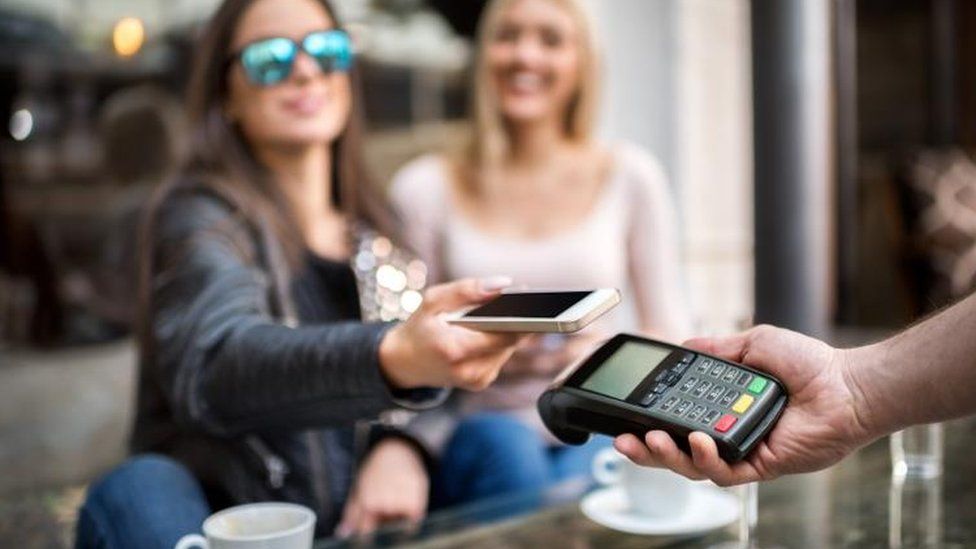Payment with Contactless cards is made three times faster than a traditional purchase made with cash or a chip card. Debit cards reach a high penetration in the countries of the region and allow us to promote contactless payments for day-to-day purchases.
Table of Contents
What is Contactless Payment? How It Works?
Definition of Contactless payments: Contactless payments are a type of payment that allows a customer to make a payment for goods or services without physically swiping, inserting, or tapping their payment card or handing over cash. Instead, contactless payments use radio-frequency identification (RFID) technology or near-field communication (NFC) to transmit payment information between the customer’s payment device (e.g., a credit card, smartphone, or smartwatch) and the payment terminal.
How Contactless payments Works:In an increasingly digital world, the way we handle financial transactions has evolved significantly. Contactless payments have emerged as a convenient, fast, and secure method of making purchases. By simply tapping a card, smartphone, or wearable device near a payment terminal, consumers can complete transactions without the need for physical contact. This technology, driven by Near Field Communication (NFC) and Radio Frequency Identification (RFID), has gained widespread acceptance, particularly in light of the COVID-19 pandemic, which has heightened the demand for touch-free solutions. As businesses and consumers continue to embrace this innovation, understanding the ins and outs of contactless payments becomes crucial.
Advantages of Contactless payments
Contactless payments offer several advantages over traditional payment methods, including:
- Convenience: Contactless payments are fast and easy to use, requiring only a quick tap or wave of a payment device to complete a transaction.
- Security: Contactless payments use encryption and other security measures to protect payment information, reducing the risk of fraud and theft.
- Hygiene: Contactless payments require no physical contact between the customer and the payment terminal, reducing the risk of the spread of germs and viruses.
- Availability: Contactless payments are widely accepted at many merchants, including grocery stores, restaurants, and transportation services.
Contactless payment solutions with Examples
Card issuers such as Visa or Mastercard already have contactless solutions and most debit and credit cards have begun to incorporate this technology. In addition, many financial entities such as La Caixa or BBVA have already implemented solutions with this type of technology.
- For example, paying a bill at a local restaurant is not the same as doing it in a country where we do not know the exchange rate with the official currency and perhaps the customer does not understand the language and, therefore, the instructions of the waiter or the terminal.
- For example, Mastercard has already created a simple guide to optimizing a customer’s experience using this technology.
- For example, giving relevant information if there is an error during the validation of the process or indicating the next action to complete.
However, the habit of use is not very widespread among users, who still prefer to hand in their card at stores. Technological manufacturers are also developing solutions in this area, such as Samsung Pay , available since June in Spain, and Apple Pay, which has no date yet but is rumored to be in the last quarter of this year.
Also Read: Reasons to Start Watching Duonao TV
What You Need To Know About Contactless Payments
To use contactless payments, a customer needs a payment device that is equipped with RFID or NFC technology, such as a contactless credit card, a smartphone with a mobile payment app (such as Apple Pay or Google Pay), or a smartwatch. To make a payment, the customer simply holds or waves their payment device near the payment terminal, and the payment is automatically processed.
- Here the providers have a lot to say: either the design is impeccable to use without additional instructions or the points of sale will have to be adequately trained.
- In addition, it is important to note that the card or contactless devices will be used at the point of sale, a moment that can become stressful if something does not work correctly and the user cannot complete the payment.
- From a design point of view, it is necessary to keep the client informed of where they are in the process, using simple language that provides timely information.
While contactless payments are becoming increasingly popular, it’s important to note that not all merchants accept them, and there may be transaction limits for contactless payments, depending on the merchant’s policies and the type of payment device being used.
The Future Of Digital Payments With Contactless Mobility
Although it is technically possible to make these types of payments with little effort, observing users in the real world paints a rather different picture.
The process is very simple on paper, as they explain in the case of VISA cards: Mobile devices also take advantage of the idea of payment in three simple steps to offer the idea of simplicity in transactions, as is the case with
Samsung Pay: Regarding the user experience, in these first months the disparity of solutions that will appear can be a problem. Until there is a certain standardization or unification of criteria among all providers, the experience will be uneven between different services, which will undoubtedly influence the user experience.
User experience in contactless devices
From a user experience point of view, there are several issues to consider.
- As with any new experience, you need to understand the customer’s needs throughout use. In these cases, in-depth research into user needs , as well as use cases and user journey design will be essential to avoid frustrating experiences.
- Also a battery of tests with users , because these experiences can be very different depending on the context where the business moves.
- On the other hand, the experience will not be satisfactory if the employee who is paid does not understand the technology.
- A poor explanation or a simple feeling of insecurity can generate distrust or laziness in the consumer when using these devices.
In short, the design and user experience that they are capable of generating will be determining factors on whether the possibilities of mobile payments will be consolidated with more or less force.
Top Ways to Secure your contactless payments
Approach and pay: Don’t you like to part with the card? With contactless payment cards, only you will be the one who handles it. You don’t need to hand it over. Make the payment of your purchases by bringing your card within 4 centimeters of the POS terminal for a few seconds, wait for a ‘beep’ and the payment will be completed.
Contactless icon: On the front of your contactless card, you will find the 4 curved bars icon. That icon should be near the POS every time you make a transaction with your debit card. Say goodbye to passing the magnetic stripes of the cards. To get an idea of the volume that this technology can reach, 50% of China’s GDP is processed through cell phones via QR code.
- Zero Cash: In addition to improving the user’s payment experience, the user will be safer, because they will carry less cash in their wallet and the queues at stores will be faster.
- Pay without a key: It is a very comfortable and safe technology. All you have to do is bring the card close and you can make a payment, many times even without entering your password.
- Rebound: If the card bounces, it can be due to two situations: the card has insufficient funds or the card does not have the contactless payment icon. In the first case, you could insert the chip into the POS and, if it doesn’t work, use another means of payment.
- Bonus track- Security: If a customer loses or steals his card, he must notify his bank immediately and from that moment, he will not be responsible for purchases made without his authorization.
Lower abandonment: Contactless payment technology allows for fewer purchases to be abandoned due to lack of cash. In this way, fewer queues are generated in stores and more sales. the most advanced country in accepting plastic in the region, where there are 2,438 POS terminals per 100,000 inhabitants, although it is still far from the 4,233 POS terminals in the United States.
Also Read: Top 10 Annoying Outlook Errors And Their Solutions
Ideal for SMEs: Contactless technology provides benefits to merchants, apart from increasing their sales. They can use this type of transaction to ensure fast and seamless checkouts and increased operational efficiency by reducing cash usage, avoiding data cloning, double purchases and unintentional purchases.
FAQs on Contactless Payments
- What are contactless payments and how do they work?
Contactless payments are a method of making purchases without physically swiping or inserting a card into a payment terminal. Instead, consumers use NFC or RFID-enabled cards, smartphones, or wearable devices to tap or wave near a terminal equipped with the necessary technology. The transaction is then processed electronically, often within a matter of seconds.
- Are contactless payments secure?
Yes, contactless payments are secure. They use encrypted data transmission and unique transaction codes, making it difficult for unauthorized parties to access sensitive information. Additionally, contactless payment systems typically have lower transaction limits, adding an extra layer of security. Many devices also require biometric authentication, such as fingerprints or facial recognition, for added protection.
- What are the benefits of using contactless payments?
Contactless payments offer several benefits, including speed and convenience, as transactions are completed faster compared to traditional methods. They also reduce physical contact, promoting hygiene and safety, especially in the context of the COVID-19 pandemic. Moreover, contactless payments can improve the customer experience by reducing wait times and providing a seamless checkout process.
- What types of devices can be used for contactless payments?
Various devices can be used for contactless payments, including NFC-enabled credit and debit cards, smartphones, and smartwatches. Payment platforms like Apple Pay, Google Pay, and Samsung Pay allow users to link their cards to their mobile devices, enabling tap-and-go transactions. Additionally, some wearable devices, such as fitness trackers and smart rings, also support contactless payments.
- Are there any limitations to contactless payments?
While contactless payments are widely accepted, there are some limitations. Not all merchants have contactless-enabled terminals, which can restrict where these payments can be made. Additionally, there are typically transaction limits imposed on contactless payments, though these limits are increasing over time. Finally, users need to ensure their devices are charged and functioning properly to complete transactions.
Conclusion
Contactless payments represent a significant advancement in the way we conduct financial transactions, offering enhanced speed, convenience, and security. As more consumers and businesses adopt this technology, it continues to shape the future of payments, providing a touch-free solution that aligns with modern needs and preferences. By understanding the mechanics, benefits, and potential limitations of contactless payments, both consumers and merchants can make informed decisions and fully leverage this innovative method of payment.











